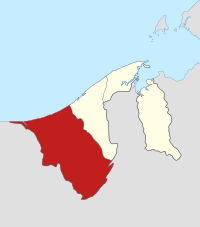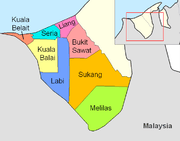Belait District
| Belait | |
|---|---|
| District | |
 | |
| Capital | Kuala Belait |
| Government | |
| • Chief of District | Awang Haji Harris Bin Othman |
| Area | |
| • Belait District | 2,724 km2 (1,052 sq mi) |
| Population (2011) | |
| • Belait District | 60,744 |
| • Density | 22/km2 (58/sq mi) |
Belait is the largest as well as the western-most district (Malay: daerah) in Brunei. The word 'Belait' is taken from the name of the native inhabitants of Belait, the Belait People. The district is administered from the town of Kuala Belait, its capital. Belait is governed by an appointed District Officer. The current District Officer of Belait is Awang Haji Harris Bin Othman and its current Belait District Assistant Officer is Awang Hasmiron Bin Haji Taib. Other major towns include Seria town and Sungai Liang.
Location and geography
The district borders the South China Sea to the north, the Bruneian district of Tutong to the east and the Malaysian state of Sarawak to the south and west.
The district covers 2,727 km2/1,052 mi², which is about half the area of the entire nation. The landscape of the district varies from the peat swamps and lowland forests near the coast to the montane rainforest in the interior parts of the district.
The Belait River (Sungai Belait) flows through Belait and it is the longest river in Brunei. The Belait River, together with its tributaries drains the district – the Belait district roughly corresponds to the drainage basin of the Belait River.

The district is further subdivided into 8 Mukims (English: sub-districts). These are often named after the most important town or village contained within. These are:
Each Mukim is composed of a number of villages or kampongs.
Population
The district has a population of around 70,000 people (2006 census) most of whom live in Kuala Belait, the main town and Seria. The native inhabitants of the district are the Belait People and together with the other Bumiputera races form a majority in the district. A minority of this population is ethnic Chinese, particularly those speaking Cantonese, Taishan, and Hakka. Ibans, Penans and other indigenous people make up the rest of the population. Also present are a large community of expatriates (Caucasians, Indians, Filipinos) mostly working with or associated with the oil and gas industry.
Although it is the second most populous district, it has the lowest average population density (23 persons per square kilometer) of all four districts due to its large area. The population distribution is uneven, the areas around the coast are more densely settled than the mountainous interior rainforests. The largest urban areas in terms of population are the district administrative capital of Kuala Belait and the oil town of Seria.
Transportation
Road
The district is connected by the Seria/Lumut bypass to the Muara-Tutong highway to the east and by the Rasau Bridge to Sungai Tujoh and Miri in the west. Roads near the coast, particularly in the urban areas of Kuala Belait, Seria and Sungai Liang are mostly surfaced and in good condition. Roads towards the interior – Labi, Melilas and Sukang – are partially surfaced, but may sustain damage from floods and landslides during the rainy season.
Rail
The Japanese built a wooden set of rail lines from Badas to the coast during the Second World War. This is no longer in use and has fallen into disrepair.
Ports and ferries
The port of Kuala Belait is one of the three ports in Brunei. It is located on the Belait river and caters to small crafts. (See Kuala Belait.)
A ferry service crosses the mouth of the Belait River linking Kuala Belait to Kg. Sg. Teraban. (This service has been ceased since 2005).
Air
There is one airfield at Anduki, a suburb of Seria. This is used mainly by Shell to transport company personnel to the offshore rigs and platforms. (See Seria.)
The interior villages of Sukang are visited by a regular flying medical service.
There are no commercial flights into and out of the district.
Economy
The Belait District, and Seria town in particular, is the heart of the oil and gas industry in Brunei. It has a large expatriate community, including many Dutch people. This is because Royal Dutch Shell has a major presence in the region.
There are two onshore oil and gas fields in the district – the large Seria Oil Field discovered in 1929 which is still producing hydrocarbons even today, and the smaller Rasau Field close to the town of Kuala Belait. The Tali Field, which is an extension of the Seria Field is found in the coastal waters off Seria. Further offshore lies the South-West Ampa, Fairley, Fairley Baram and Egret fields.
The petroleum produced is processed onshore in and around Seria and the majority of it is exported. Some of the oil is refined at the refinery in Seria for local consumption. Natural Gas from the fields are sent to the Brunei Liquefied Natural Gas Plant (BLNG) in Lumut where it is cooled and liquefied. This is exported via tankers to mainly Japan and Korea.
In the eastern part of the district, Liang is currently experiencing a major development with the establishment of SPARK, which is a 271 hectare site developed to be a world class petrochemical hub. The first major investment at SPARK is the USD450 million Methanol plant developed by the Brunei Methanol Company, a joint venture between Petroleum Brunei and two leading Japanese companies, Mitsubishi Chemical Holdings Corporation and Itochu Corporation. The plant is scheduled for completion in the first quarter of 2010.
Coordinates: 4°25′N 114°35′E / 4.417°N 114.583°E